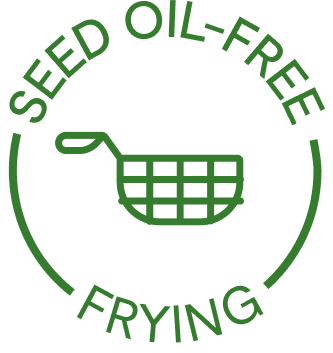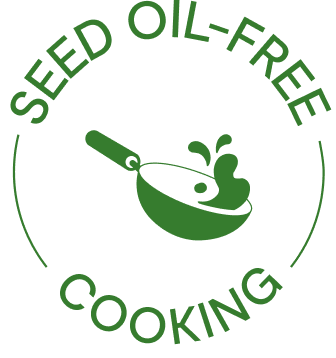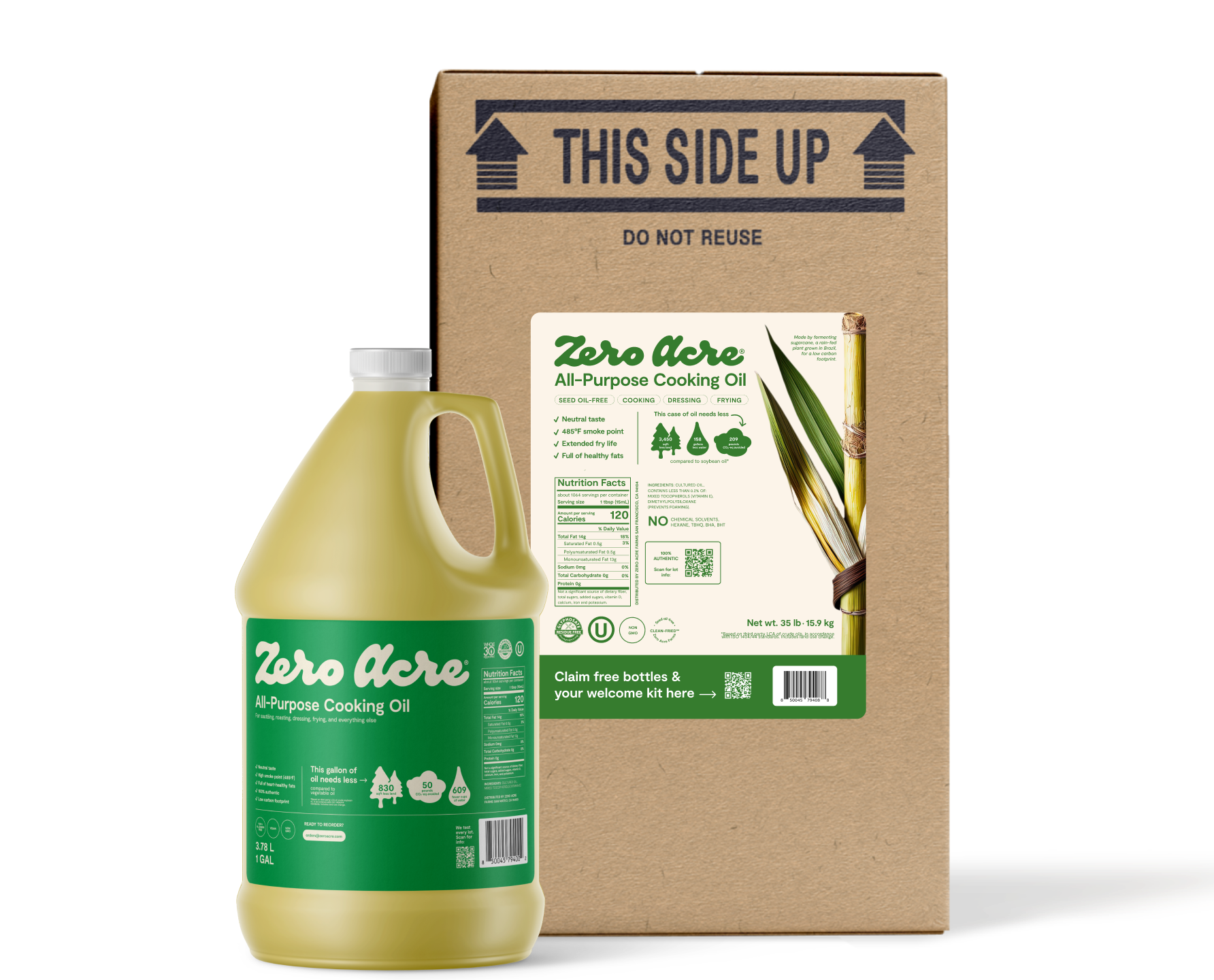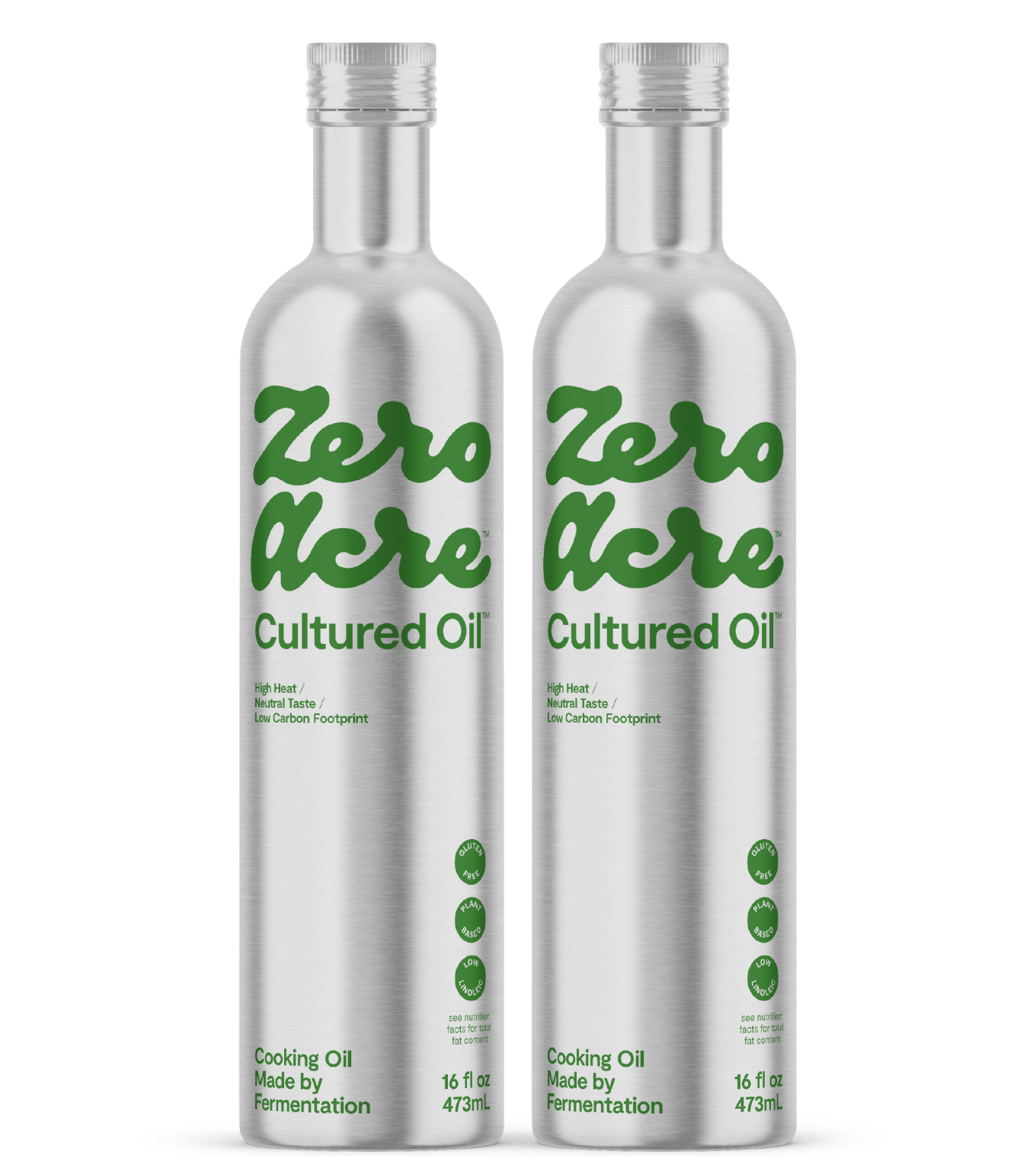WRITTEN BY: Corey Nelson
Article at a Glance
Fats are an important source of energy and nutrition and play essential roles in your body.
The nutritional quality of fat sources and their fatty acid profiles determine whether or not fats are healthy.
Liquid fats like olive oil and avocado oil are high in heart-healthy monounsaturated fats.
Vegetable oils made from seed crops are high in inflammatory polyunsaturated omega-6 fats.
Solid fats from animal products and coconuts are high in saturated fats.
Aside from pure fats and oils, whole foods like seafood and nuts are also excellent sources of healthy fats.
The science of healthy fats is constantly evolving. The latest research informs us which fats and fatty acids are nutritionally valuable and which are harmful.
Introduction
There was a time not long ago when public health authorities recommended everyone eat a low-fat diet, but that advice backfired [*,*]. Instead of making healthier food choices, most people began replacing calories from fats with highly processed foods that had virtually no nutritional value [*].
Many experts would argue that low-fat public health messaging was a massive failure with measurably negative health impacts across the board, including climbing rates of obesity and cardiovascular disease [*,*].
Fortunately, more people today understand the importance of eating healthy fats, from plant-based to keto diet followers. After all, fats are a critical source of energy and nutrition in the human diet. The trick is to zero in on wholesome, nutritious fat sources that match your dietary needs and priorities.
This article covers everything you need to know about choosing healthy fats, including the essential roles fats play in your body, the pros and cons of 40-plus popular fats and oils, the benefits of different types of fatty acids, and more.
How to Choose Healthy Fats
Choosing the best fat for your diet isn’t impossible. It does involve considering things like fatty acid composition (polyunsaturated, monounsaturated, and saturated fats), each fat source’s health benefits, flavor, whether you'll be cooking at high heat, and environmental concerns.
Fatty Acid Composition
Fatty acid composition is the most significant nutritional aspect to consider when you're choosing healthy fats. Fundamentally, all naturally-occurring fats contain some combination of polyunsaturated, monounsaturated, or saturated fatty acids.
Polyunsaturated Fats
Polyunsaturated fats are the least stable fats. While omega-3 and omega-6 polyunsaturated fats are essential in low amounts, omega-6 linoleic acid, in particular, is associated with health problems above required intake levels [*,*,*,*,*,*,*].
The other problem with polyunsaturated fats is that they begin to break down when heated (even below their smoke point) during manufacturing and cooking, as well as during storage, creating harmful byproducts that taste rancid and are far from healthy [*,*].
Monounsaturated Fats
Heart-healthy monounsaturated fats are more stable and, therefore, suitable for cooking [*]. In addition, some monounsaturated fat sources like olive oil contain polyphenol antioxidants associated with health benefits in studies [*].
Saturated Fats
Common saturated fats, mainly found in animal products, are associated in some research with high cholesterol and cardiovascular disease [*]. However, this topic is now controversial in public health advocacy, with some credible researchers sharing that saturated fat reduction isn't effective for improving public health based on available data [*,*].
Whether or not you choose to limit or avoid common long-chain saturated fats from animal products, short-chain fatty acids (SCFAs) and plant-based medium-chain triglycerides (MCTs) aren't associated with the same health problems as other saturated fats [*]. Plus, they may have beneficial properties not found in other saturated fatty acids [*,*].
Flavor and Texture
The flavor of fats may not matter if you're using them as dietary supplements to boost your energy, but it certainly matters for culinary purposes. For example, the mild, grassy, avocado-like taste of avocado oil might not work as a cooking oil substitute in a vanilla cake recipe, but it could be an excellent salad dressing ingredient.
Other fats like olive oil may taste good in dressings and marinades but don’t work for high-heat cooking and tend to clump when stored in the refrigerator.
Environmental Impacts
Environmental impacts and related concerns around oils include land use, water footprint, pollution, deforestation, effects on biodiversity, and fair labor practices. While they might not be the main drivers in your decision, understanding these issues helps you make a fully informed choice.
The Best and Worst Liquid Fats (Oils)
Oils are fats that are liquid when cool and at room temperature, which means that many of them are higher in polyunsaturated fats. Here are some of the most popular oils, their health benefits, and their environmental impacts.
Zero Acre Oil
Zero Acre oil is an all-purpose cooking oil made through fermentation. It's versatile, high in heart-healthy monounsaturated fats, and very environmentally friendly.

Benefits
Zero Acre oil contains more than 90% monounsaturated fatty acids, the same heart-healthy fats found in olive oil and avocado oil.
Contains less than 3% omega-6 linoleic acid.
Sky-high smoke point of up to 485°F.
Extremely stable for heating and cooking.
Light, fresh, neutral taste that goes well with any dish.
Natural antioxidants known as mixed tocopherols, a form of vitamin E, help protect against oxidation and rancidity.
Environmentally friendly with 87% less land use than canola oil, 86% lower emissions than soybean oil, and 99% lower water requirement compared to olive oil.
How to Use Zero Acre Oil
Zero Acre oil is an all-purpose cooking oil that stays liquid in the fridge and at room temperature and boasts one of the highest smoke points on the market. That means you can use it for everything from homemade dressings and marinades to baking and high-heat stir-frying and sauteing.

Olive Oil
Olive oil is a golden-green oil that’s famous for its role in the Mediterranean diet. It’s known for being a heart-healthy fat option and can be found in many dressings, marinades, and recipes from the Mediterranean region.
Pros
High in heart-healthy monounsaturated fats and vitamin E [*].
Extra virgin oil is rich in beneficial polyphenol antioxidants [*].
Studies suggest health benefits, including improved cholesterol, lower risk of cardiovascular disease or death, healthier metabolism, and reduced inflammation [*].
Stable when used as cooking oil for medium-heat sauteing or frying, with typical smoke points of 350-406°F [*].
The nutty, grassy olive flavor can complement some recipes.
Cons
Some olive oil varieties contain as much as 21-27% omega-6 linoleic acid [*].
Olive oil is not environmentally friendly regarding land use, water consumption, or emissions [*,*].
Clumps or becomes solid when refrigerated.
Up to 80% of imported olive oil may be adulterated or contaminated with other oils [*].
How to Use Olive Oil
Olive oil is versatile and easy to incorporate into your diet. You can add it to any recipe that calls for fats, use it as a cooking oil, or even take it by the spoonful.
If you use olive oil as a salad dressing ingredient, either make small batches you can use in a single meal or ensure there's time for it to warm and liquefy after refrigerated storage.
Avocado Oil
Avocado oil is a yellow-green oil pressed from the pulp of avocados. While avocados have been a food staple in the Americas for thousands of years, avocado oil is relatively new as a culinary oil option with popularity only growing in the last decade or so.
Pros
A rich source of healthy monounsaturated fats and vitamin E [*,*].
Excellent thermal stability and a smoke point of 428-482°F [*].
Mild grassy flavor that goes well in most dishes.
Cons
There's currently very little research on the human health benefits of avocado oil [*].
Contains 13.4% omega-6 linoleic acid on average [*].
Significant negative environmental effects around land use, water consumption, and biodiversity loss [*,*,*].
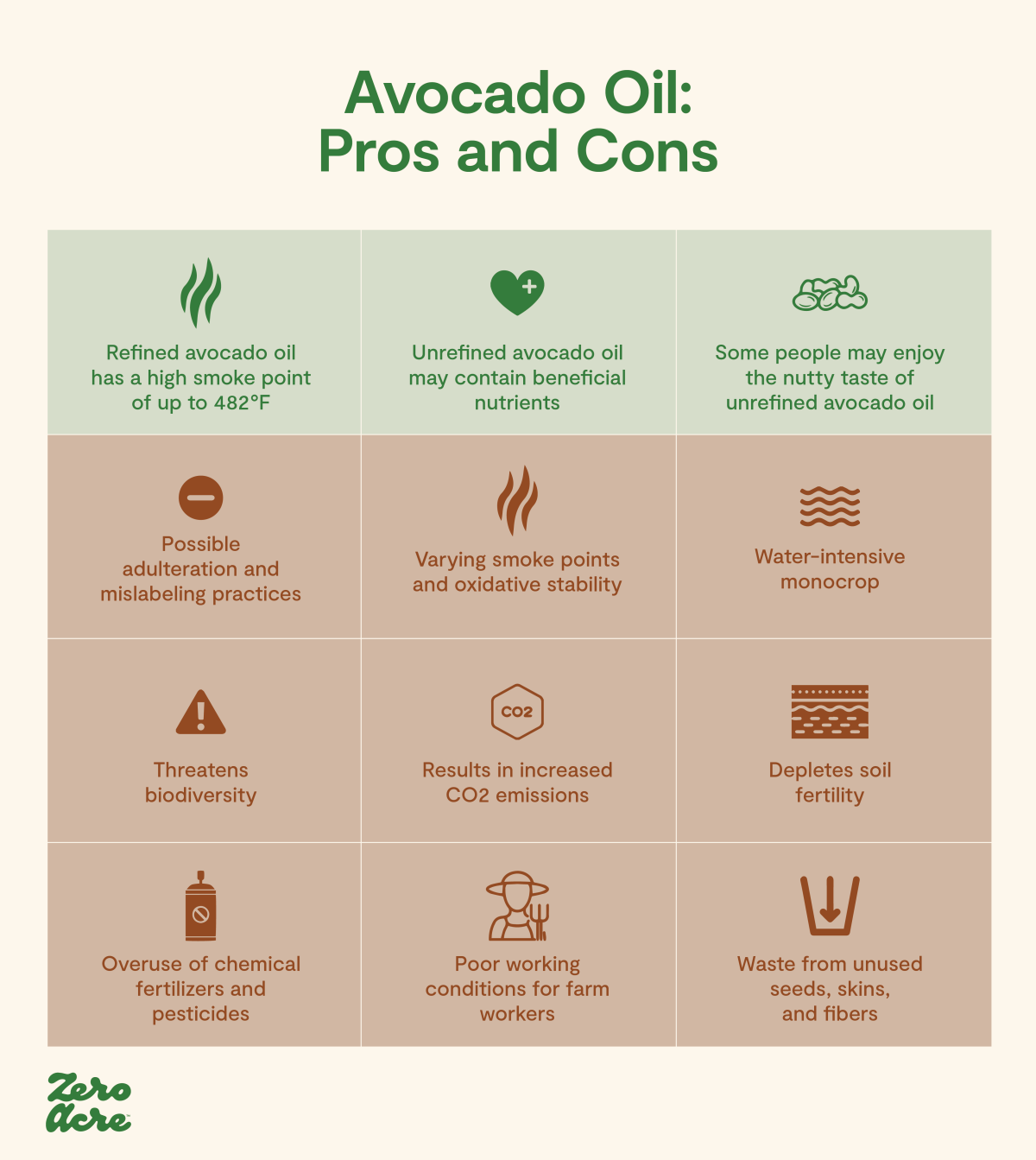
How to Use Avocado Oil
Avocado oil shines as a versatile high-heat cooking oil, but you can use it in any recipe to boost your healthy monounsaturated fat intake. However, you might want to avoid it in baking, as its grassy flavor can make its way into cakes, cookies, and more.
MCT Oil
Medium-chain triglyceride (MCT) oil is a fat supplement derived from coconut oil or palm oil. Because the fatty acid chains are shorter, it's very easy for your body to digest and absorb [*]. MCT oil is also available in a powdered supplement form that mixes with liquids more easily.
Pros
May support fat-burning and healthy weight loss [*].
Research suggests MCTs may improve exercise endurance and energy metabolism [*].
MCT oil increases the production of ketones, which may be beneficial for brain health [*].
A study found MCT may support a healthy microbiome and healthy bowel movements [*].
MCT oil is flavor-neutral with a rich mouthfeel.
Cons
Not suitable for heating or cooking due to its low thermal stability and low smoke point (under 350°F) [*], so it’s not generally considered a cooking oil.
Costs 2-3 times more than oils like olive oil and avocado oil.
Consuming too much MCT oil at once can result in diarrhea and upset stomach.
Most (but not all) MCT powder supplements contain starchy carbohydrates or other fillers.
Because it comes from coconuts or palm fruits, MCT oil production is also associated with unfair labor practices, the loss of rainforests, and reduced tropical biodiversity [*,*]
How to Use MCT Oil
You can take 1-3 teaspoons (5-15 ml) orally or add MCT oil to shakes, smoothies, or other recipes that don't require heating. Higher MCT doses are more likely to cause diarrhea and upset stomach, but spreading your intake throughout the day may help.
Seed Oils
Vegetable oils made from seed crops, including canola, corn, cottonseed, grapeseed, peanut, rice bran, safflower, soybean, and sunflower oil are one of the most common sources of calories in modern diets [*].
This trend reflects the ever-increasing use of inexpensive seed oils as cooking oils and ingredients in highly processed, packaged foods. Soybean oil consumption, for example, increased 1,000-fold between 1909-1999 [*].
In the 1960s-1970s, some researchers claimed polyunsaturated linoleic acid, the primary fatty acid in seed oils, was heart-healthy. But recent reevaluations of this data, which includes nearly 11,000 study participants, suggest that increasing seed oil intake is linked with health problems including inflammation, obesity, and cardiovascular disease [*,*,*].
Pros
Although historically inexpensive, seed oil prices are on the rise, up 20-50% per year for the past three to four consecutive years [*,*,*].
Neutral in flavor, subsidized, and widely available for most restaurants and packaged food manufacturers.
Cons
Seed oil consumption is associated with current average linoleic acid intakes of 6-10%, far higher than the 1-2% daily requirement [*,*].
Omega-6 seed oils are thermally unstable and break down quickly during manufacturing, storage, and cooking, creating harmful byproducts and rancid flavors [*,*].
Seed oils result in excessive land and water use [*,*,*,*,*].
Pollution as a result of herbicides, pesticides, and solvent-based industrial processing
How to Avoid Seed Oils
Seed oils high in harmful linoleic acid are in most restaurant meals and processed foods. You can cook fresh foods at home using healthy alternative cooking oils instead. When you eat out, you can request grilled or roasted meat and vegetables with no oil.
Nut Oils
Nut oils are specialty oils extracted from nuts. Because of their high cost and culinary properties, they're rarely used for cooking and are more often used in dressings.
Pros
Nut oils like almond oil, avocado oil, hazelnut oil, and macadamia nut oil are usually high in heart-healthy monounsaturated fat [*].
Cons
Nut oils are expensive.
Some nut oils, including walnut oil, are high in omega-6 linoleic acid [*].
Most nut oils aren't heat-stable and have low smoke points [*]
Industrial processing (as opposed to cold pressing) damages the polyunsaturated fatty acids in nut oils [*].
How to Use Nut Oils
You can use nut oils as an ingredient in unheated sauces or dressings or include them in your healthy fat rotation, but whole nuts are generally a more economical choice with more nutritional value.
The Best and Worst Solid Fats
Fats that are solid at room temperature are high in saturated fatty acids. Except for coconut and palm oil, most solid fats are animal-based (like butter and lard). You can learn which solid fats are best for your needs here.
Coconut Oil
Coconut oil is a solid white fat at room temperature. It liquefies and becomes clear at temperatures of 77-86°F or higher [*].
Pros
Extremely low levels of omega-6 linoleic acid (<2%) [*].
Mild, slightly sweet coconut flavor for those who enjoy the taste of coconut.
Can add a crisp texture and rich mouthfeel to recipes.
Contain plant-based saturated fats that may have distinct nutritional and metabolic benefits [*]
Refined coconut oil has a smoke point of up to 406°F [*].
Cons
There's limited research on the potential health benefits of coconut oil [*].
People who strictly limit saturated fat may choose to avoid coconut oil, as it contains 82.5% saturated fats [*].
Coconut oil has a strong coconut flavor, which can affect the taste of most dishes.
Virgin coconut oil has a smoke point of 340-380°F [*].
Coconut oil production has a significant environmental impact and is linked with the loss of tropical biodiversity [*].
How to Use Coconut Oil
You can add coconut oil to smoothies or use it for baking or cooking. Be sure to use refined coconut oil if you're frying.
Butter, Clarified Butter, and Ghee
Butter is a dairy product made from the milk of cows or other ruminants (grazing animals with multiple stomachs). It's solid at room temperature and begins to melt around 90-95°F.
Clarified butter is butterfat with the milk solids and water removed. To make it, you can melt butter over low heat without boiling it, skim the milk solids off the top, and then pour the liquid butterfat into a separate container while leaving the remaining water in the bottom of the pot.
Ghee is made by simmering butter for 25-30 minutes to boil off the water content, then straining out the caramelized milk solids. It's a golden liquid at temperatures of 76°F or higher.
Pros
Butter is very low in linoleic acid (3.5% of fatty acids), even if cows are fed diets high in linoleic acid [*,*].
The smoke point of clarified butter and ghee is approximately 482°F [*].
Many people enjoy the taste of butter in cooking and baking.
A recent meta-analysis found "relatively small or neutral overall associations" between butter consumption and cardiovascular disease or other health problems, suggesting butter may be fine to consume in moderation [*].
Research suggests that pastured dairy cows or other animals raised using regenerative agriculture methods can have a positive environmental impact [*].
Cons
Butter's smoke point is 350°F.
You can't eat butter if you're vegan because it's an animal product.
Due to its lactose content, butter may cause digestive issues for those who are lactose intolerant – an estimated 68% of the world’s population [*].
How to Use Butter or Ghee
If you're heating recipes above 350°F, be sure to use clarified butter or ghee instead of butter.
Butter Substitutes (Margarine, Spread, Etc.)
Butter substitutes like margarine or tub spread imitate butter by adding solidifying agents to polyunsaturated fats [*]. Before trans fats were banned, many butter substitutes contained harmful trans fats.
Pros
Some butter substitutes contain added plant sterols that may have health benefits [*].
Most butter substitutes are vegan, which offers a non-animal-based alternative for vegans.
Cons
Most butter replacements contain seed oils high in omega-6 linoleic acid (37% for a typical margarine) [*].
How to Avoid Butter Substitutes
Butter substitutes are bad because they're high in linoleic acid and don’t offer many health benefits. If you're vegan or wish to avoid real butter altogether because of saturated fats, you can try Zero Acre oil or use banana or mashed avocados to add richness to your favorite recipes.
Rendered Animal Fats
Rendered animal fats include tallow (beef fat), lard (pork fat), schmaltz (chicken fat), duck fat, and more. Before low-cost seed oils became available, most people used these fats for cooking [*].
Pros
Desirable flavor and texture properties for some recipes.
Typically high smoke point of around 400ºF.
Inexpensive to make your own by rendering (cooking down) trimmings and scraps.
Fats from cows and other ruminants (animals with multiple stomachs) are low in inflammatory linoleic acid regardless of their diet [*].
Non-ruminant animals' fat products are low in linoleic acid when they consume a pastured diet free of corn and soy [*,*,*].
Animals raised with regenerative agriculture could have a net positive impact on the environment [*].
Cons
Non-ruminants (like pigs and poultry) are typically fed a fattening diet high in omega-6 linoleic acid, resulting in high levels of linoleic acid in their fat products [*,*,*].
Large-scale industrial animal production is associated with devastating environmental impacts and ethical issues regarding animal treatment [*,*].
How to Use Rendered Animal Fats
Unlike most of the fat sources we've covered, rendered fats aren't palatable to eat by the spoonful. Instead, you can use them as cooking oils or add them to baking recipes that call for solid fats like butter or coconut oil.
Other Fat Sources
Whole food fat sources are a convenient, nutritionally balanced way to incorporate more healthy fats into your diet. Unlike pure fats and oils, these foods also contain protein and diverse micronutrients to nourish your body.
Seafood for Omega-3 Fats
Fatty fish and seafood are naturally high in omega-3 EPA and DHA and low in omega-6 linoleic acid [*]. These polyunsaturated omega-3 fats are essential (your body can't produce them from other nutrients) and help reduce inflammation [*].
Some of the best seafood sources of omega-3 fats include salmon, sardines, anchovies, oysters, clams, and shrimp. Smaller animals in the marine food chain also tend to have lower levels of mercury and other contaminants than larger species [*,*].
Unlike fish oil or omega-3 supplements, intact fish and seafood are high in the phospholipid forms of EPA and DHA, which absorb better and are less prone to oxidation [*]. The form of DHA found in seafood may also be easier to absorb into the brain compared to omega-3 supplements [*].
Journalists and researchers have reported that 10-50% of fish oil supplements are rancid or slightly below the rancidity limit [*]. Supplements are convenient, but real, sustainable, low-mercury seafood is a much better way to meet your omega-3 needs.
Most health authorities recommend eating several servings of non-fried seafood for omega-3s each week [*]. Also, be sure you reduce your omega-6 linoleic acid intake to achieve an appropriate essential fatty acid ratio for optimal health [*].
Nuts, Seeds, and Nut and Seed Butters
Nuts and seeds contain an array of beneficial fatty acids with none of the downsides of industrially processed seed oils. They also offer extra protein, fiber, and highly bioavailable vitamins and minerals [*].
Use nuts or seeds in moderation as on-the-go snacks, in smoothies, or as an ingredient in salads or other dishes.
The most nutritious nuts and seeds include:
Almonds
Brazil nuts
Cashews
Chestnuts
Hazelnuts
Macadamia nuts
Pistachios
Walnuts
Chia seeds
Flaxseeds
Hemp hearts (dehulled hemp seeds)
Pumpkin seeds
Sunflower seeds
Nut and seed butters have the same nutritional value as the foods from which they're made — they're interchangeable.
Some nuts do contain omega-6 linoleic acid, but if you eat nuts in moderation (not multiple pounds per day!), it's not an issue.
Just make sure you choose brands that don't add omega-6 seed oils to the jar and consume nuts and seeds in moderation.
Avocados and Other Fatty Plant Foods
Avocados are high in monounsaturated fats, low in omega-6 linoleic acid, and an excellent source of fiber, potassium, magnesium, and plant antioxidants [*]. You can eat them fresh, add them to smoothies, make guacamole, prepare avocado toast, mix them into omelets, or use them in salads.
Coconuts are another natural source of plant-based fats that are low in linoleic acid. You can eat coconut products as a snack or add them to smoothies or other recipes.
Fresh or pre-frozen coconut "meat," the solid, edible portion of coconuts, contains plant-based saturated fats, fiber, potassium, magnesium, and phosphorus [*].
Coconut milk sold for cooking has a similar nutritional profile but less dietary fiber [*]. It's a staple ingredient in many curries, soups, and fruity tropical drinks.
Eggs
Eggs with intact yolks have a diverse fatty acid profile and are high in protein, choline, selenium, and riboflavin [*].
Remember that chickens, ducks, and other birds fed corn and soy lay eggs high in omega-6 linoleic acid, so you'll want to choose pastured eggs from birds that primarily eat a natural foraging diet and aren’t fed corn or soy [*].
Dairy Products
If you don't have allergies to lactose or casein, dairy products from cows or goats are another way to meet your energy needs with some added benefits.
Milk and cheese are good sources of fats, low in linoleic acid, and contain high-quality protein and calcium [*,*].
Probiotic cultured dairy foods like yogurt and kefir are high in protein and also support a diverse gut microbiome [*].
Meat
High-quality meats are an excellent source of protein, contain a diverse fatty acid profile, and are rich in vitamins and minerals, including riboflavin, B-12, iron, potassium, zinc, selenium, [*,*,*].
Meats from ruminants like cows, goats, sheep, deer, and other grazing animals with multiple stomachs don't contain high levels of omega-6 linoleic acid, regardless of their feed [*]. While there are ethical and environmental reasons to avoid industrially raised animal products, linoleic acid content isn't a concern with beef, lamb, mutton, or venison.
However, pork, poultry, and the meats of other non-ruminants have fatty acid profiles that reflect the animals' diets [*,*,*]. Choose pastured, corn-free, and soy-free pork and poultry to reduce your linoleic acid consumption and support regenerative farming practices.
Why We Need Fat
Along with protein and carbohydrates, fat is one of the three macronutrients in the human diet. Macronutrients like fat are where calories in your diet come from, providing energy and building blocks for cells.
Fats in Your Diet
Most modern diets contain between 20-40% of calories from fats, with the average person today consuming about a third of their total calories from fats [*,*]. Traditional hunter-gatherer diets are estimated to contain anywhere from 28-58% or more calories from fat, depending on location and season [*].
Today, some people follow diets that are lower or higher in fat. For instance, very-low-fat diets may contain less than 20% fat by calories, while the ketogenic diet and other high-fat diets usually contain around 55-80% of calories in the form of fats [*,*,*].
Researchers have found that when given a choice, most people throughout history have consumed as much fat as was available because it's an excellent source of calories and nutrients, providing 9 calories per gram (as opposed to 4 calories per gram for protein or carbohydrates) [*]. They also aid in the absorption of the fat-soluble vitamins A, D, E, and K [*] — all of which may have helped human brain development during evolution [*].
And fats aren’t just good for you. They also boost the flavor and textures of food when used for sauteing or frying or as an ingredient in sauces, marinades, or dressings.
Fats in Your Body
In addition to being a major source of calories in your diet, fats play other important roles in your body.
Dietary fats play an essential role in the production of hormones and related signaling molecules at the cellular level [*]. They also contribute to protective membranes for your cells, nervous system, and brain [*].
Stored fat, or adipose tissue, is a critical energy reserve and influences how your metabolism and endocrine (hormonal) system work [*,*]. Recommended body fat ranges for men are about 12-20% and 20-30% body fat for women [*].
Is Dietary Fat Good or Bad?
The most recent evidence suggests that you can be healthy with a relatively low- or high-fat diet, and different ratios may work better for different people [*]. The types and quality of fats and other macronutrients you eat are what matter most for health [*]. That's why choosing healthy fats is so crucial.
If you were alive in the 1980s or '90s, you probably remember that many experts once recommended a low-fat diet [*]. At the time, some research linked high-fat diets with health problems, but newer studies paint a more complex picture that no longer demonizes fat [*].
Unfortunately, low-fat public health advice backfired because many people replaced fats with highly processed foods and similarly unhealthy sources of calories [*].
In other words, there's a huge difference in the health effects of eating a diet high in fresh, nutritious foods versus eating a lot of ultra-processed, packaged foods that are high in calories but low in nutrients.
Many large studies have found links between ultra-processed foods and obesity, metabolic issues, cardiovascular disease, cancer, depression, and other health problems [*].
That's why public health advice that focuses exclusively on lowering fat intake and steers people toward eating low-quality replacement foods fails.
The Takeaway
Instead of searching for a single "perfect" healthy fat, keep a rotation of several fat sources that can meet your needs for healthy energy, recipes, and cooking.
Remember that finding the right fats is always about navigating different trade-offs, including price, fatty acid content, health benefits, heat stability, and environmental impact.
Avoiding unhealthy fats, especially seed oils high in harmful polyunsaturated omega-6 linoleic acid, is also essential.
Unfortunately, no amount of omega-3s or other healthy fats can compensate for a high intake of inflammatory linoleic acid unless you reduce your omega-6 intake first.

